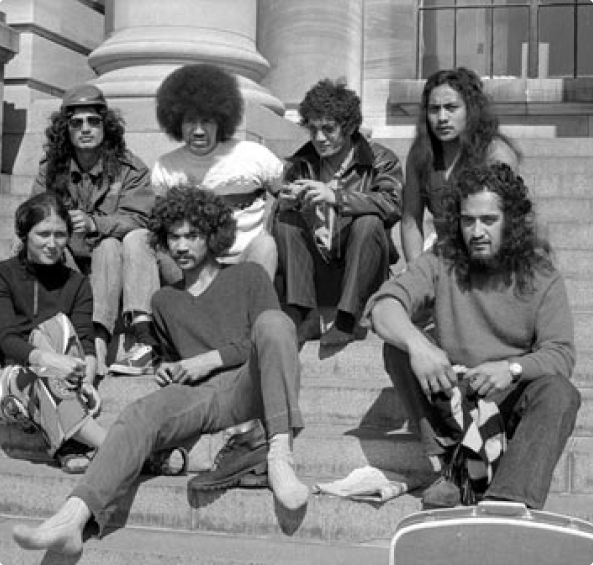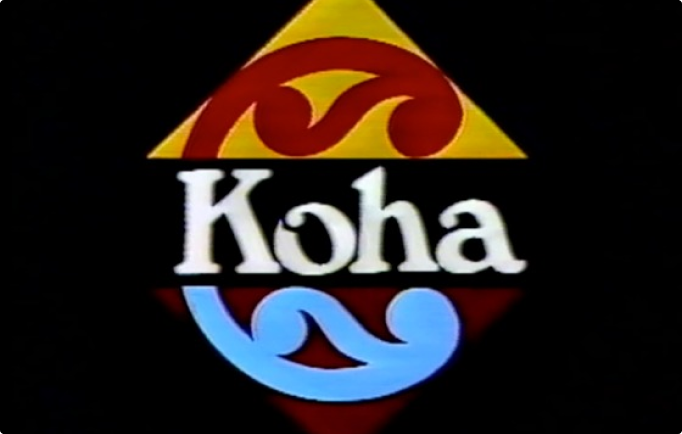1960-1970
Emergence of Māori language advocacy groups - Te Reo Māori Society and Ngā Tamatoa

1970-72
Māori Language Petition presented
Hana Jackson of Ngā Tamatoa and Lee Smith of Te Reo Māori Society present a 30,000-signature Māori Language Petition to Parliament calling for te reo and tikanga Māori to be promoted in schools
1975
The first Māori Language Week is celebrated
1976
NZ Māori Council makes submissions on a Broadcasting Bill
The New Zealand Māori Council chaired by Graham Latimer makes submissions on a Broadcasting Bill, calling for a weekly TV programme covering Māori and Polynesian affairs, a series of simple, five-minute education programmes aimed at Māori, and a Māori radio station.
1978
Rūātoki School becomes the first bilingual school in New Zealand
1980
Television New Zealand screen ‘Koha’ - a 30-minute Māori magazine programme
Regular Māori programmes started on Television New Zealand in 1980 with Koha, a weekly, 30 minute programme broadcast in English. It explored everything from social problems, tribal history, natural history, about weaponry, to the preparation of food, canoe history, carvings and their meanings, language and how it changed through time. It was a window into te ao Māori for Pākekā, and provided a link to urban Māori estranged from their culture. It was the first regular Māori programme to be shown in prime time.

1980
Experiments in Māori radio broadcasting lead to the establishment of Te Upoko o te Ika and Radio Ngāti Porou
1981
A petition calls for Māori to be made an official language of New Zealand
1982
The first kōhanga reo opens at Wainuiomata in 1982
1983
Te Karere goes to air for the first time: Derek Fox and Whai Ngata are hosts
1985
Te Reo Māori Claim WAI 11 is brought before the Waitangi Tribunal by Ngā Kaiwhakapūmau i te Reo Māori
Huirangi Waikerepuru, the chairman of Ngā Kaiwhakapūmau i te Reo, led the claim to the Waitangi Tribunal leading to the Māori Language Act of 1987.
1986
Report of the Waitangi Tribunal on the Te Reo Māori Claim (WAI 11)
The report asserts that te reo is a taonga guaranteed protection under Article II of the Treaty of Waitangi and recommends that legislation be introduced to enable Māori language to be used in courts of law, and that a supervising body be established by statute to supervise and foster the use of the Māori language
1986
TVNZ’s Māori department is established, set up by Whai Ngata
Ngā Take, a 10-minute current affairs series, broadcasts on TVNZ.
1987
The Māori Language Act is passed in Parliament and Māori is declared an official language
- Te Taura Whiri i te Reo Māori (the Māori Language Commission) is established.
- TVNZ's te reo-only one hour-long magazine programme Waka Huia begins
1989
The Broadcasting Act is passed
- The start of the broadcasting assets case, a series of 14 legal actions that went as far as the Privy Council seeking Māori rights to the airwaves.
- The Government reserves radio and television broadcasting frequencies for use by Māori.
1994
We’re born! Te Reo Whakapuaki Irirangi (Te Māngai Pāho) is established under the Broadcasting Amendment Act and begins as a funding agency to support Māori language and culture in broadcasting.
1996
Te Māngai Pāho calls tenders for a free-to-air trial service of an Auckland UHF Māori television channel
The project does not succeed and a joint Māori/Crown working party on Māori television is established. Consultation the next year shows support for a stand-alone, national Māori television service.
1997
The Government announces funding for a Māori television channel
2001
The Government announces the establishment of a Crown-owned Māori Television Service (MTS)
- Government works through foundation issues with Te Awhiorangi (Te Reo Māori Television Trust)
- Te Awhiorangi is later dissolved and a Board created in its place
- Punga.net is launched
2003
The Māori Television Service (Te Aratuku Whakaata Irirangi Māori) Act is passed in Parliament
Also this year, Launch of irirangi.net – live streaming of Te Māngai Paho iwi radio stations.
2004
Mā rātou, mā mātou, mā koutou, mā tātou - Māori Television is launched
New Zealand’s indigenous broadcaster, Māori Television, is launched providing a wide range of local and international programmes for audiences.
2008
A second Māori Television Channel, Te Reo, is launched, offering fluent content to audiences
- Te Māngai Pāho celebrates over 500,000 hours of Māori language programming.
- Te Taura Whiri i te Reo Māori publishes the first only monolingual Māori dictionary, He Pātaka Kupu: He Kai a Te Rangatira.
- Te Māngai Pāho invests into digital and online programming
2013
ZePA model developed by Dr. Poia Rewi & Professor Rawinia Higgins
2015
Kōkako software launched
2016
Te Ture mō te Reo Māori 2016 passes in April
- The second bilingual Act and the first in which the Māori language has precedence. It includes a Crown acknowledgement of past harm it had inflicted in te reo Māori and a commitment to its revitalisation
- Te Mātāwai is established
2018
The first series of Ahikāroa premieres
2019
Te Māngai Pāho celebrates 25 years and the Waiata Anthems album is released
The Waiata Anthems album features te reo versions of popular Aotearoa tracks from some of New Zealand's most iconic musicians including Shapeshifter, Six60, Sons of Zion, Kings, Drax Project and Bic Runga.